AWS EC2 General Purpose Instance Types
General Purpose
This type of instance supplies the user with a balance of the resources mentioned below :
- Compute
- Memory
- Networking
It may also be utilized for multiple workloads.
Particularly, those instances are perfect for and favored by a wide variety of companies that require apps that rely on resources in equivalent proportions, like code repositories & web servers.
Under the General Purpose type of instance, there are 9 different categories of instances:
1. A1
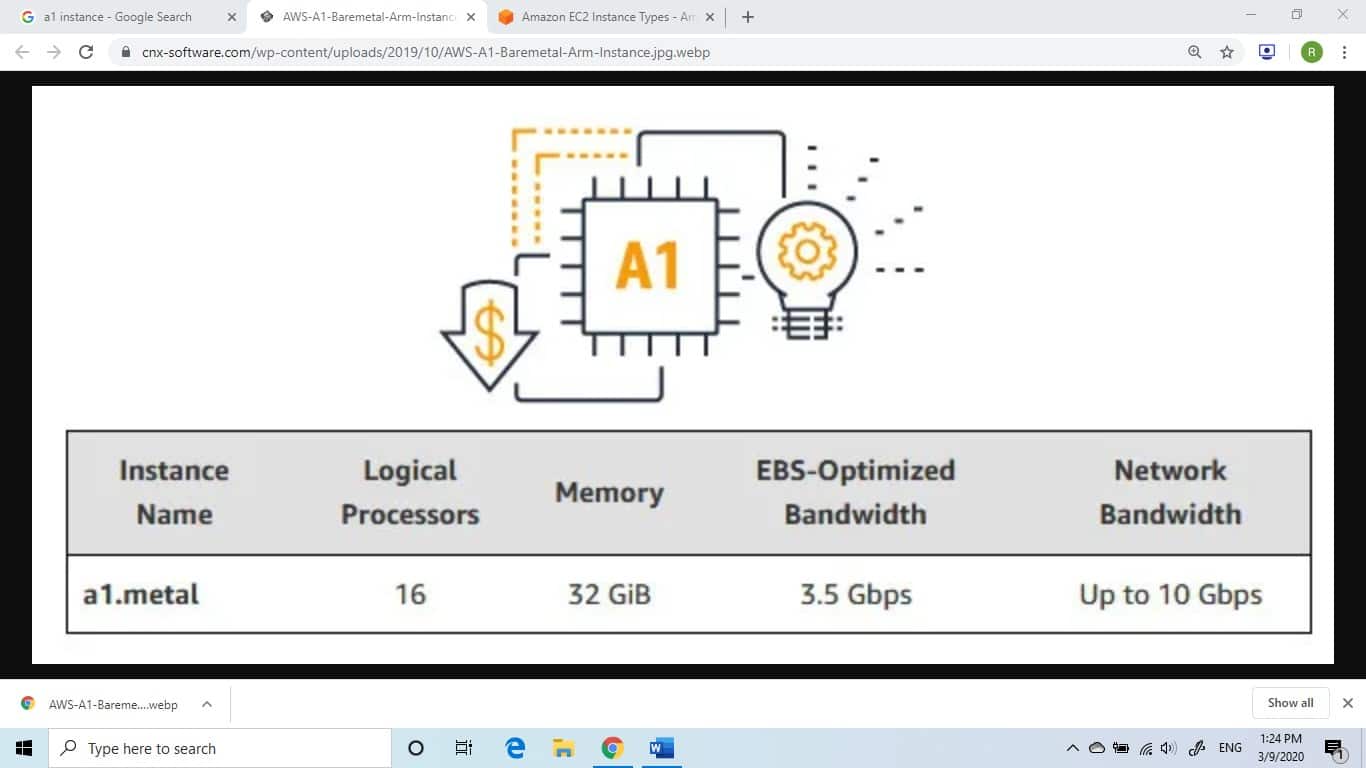
ec2 a1 instance type
A1 instances are known for:
– Delivering paramount cost savings
– Being perfectly suited for scale-out
– Being suited for Arm-based workloads (Supported by extensive Arm ecosystem)
– Being the first EC2 instances that are powered through “Graviton Processors” (64-bit Arm Neoverse cores and custom silicon designed by AWS)
Its Features are:
- A custom-built Graviton Processor (64-bit Arm Neoverse cores)
- Gives support for Enhanced Networking (to 10 Gbps of bandwidth)
- EBS-optimized (default)
- It is powered through “Nitro System” (dedicated hardware + lightweight hypervisor)
| Instance | vCPU | Mem (GiB) | Storage | Network Performance (Gbps) |
| a1.medium | 1 | 2 | EBS-Only | Up to 10 |
| a1.large | 2 | 4 | EBS-Only | Up to 10 |
| a1.xlarge | 4 | 8 | EBS-Only | Up to 10 |
| a1.2xlarge | 8 | 16 | EBS-Only | Up to 10 |
| a1.4xlarge | 16 | 32 | EBS-Only | Up to 10 |
| a1.metal | 16* | 32 | EBS-Only | Up to 10 |
Note: a1.metal supplies with 16 physical cores
Specs of every instance:
- Custom built “Graviton Processor” (64-bit Arm cores)
- It is EBS Optimized
- Better Networking
The Use Cases of A1:
– It is used for scaling-out workloads (like web servers)
– It is used for containerizing microservices
– It can be used to cache fleets
– It is used in distributed data stores + development environments
2. T3

ec2 T3 instance type
They are known for being the newest generation of burstable, general-purpose instance types, which do the following:
– Give a baseline level for the performance of the CPU
– Offer the ability to burst CPU usage whenever needed for an infinite time required
– Supply us with a balance of network, compute and memory resources
– Made for the apps that have moderate usage of CPU, which get into temporary spikes while being used
– Adds up CPU credits every time the workload is working under the baseline threshold
Every single earned CPU credit will give T3 instance a chance to start bursting with performing as a complete CPU core until 1 minute of time whenever required. For Unlimited mode, the T3 instances have the ability to burst whenever wanted for an infinite time period.
Its Features include:
- Burstable CPU, governed by CPU Credits, and consistent baseline performance
- Unlimited mode (default): for ensuring well performance when in peak periods. Standard mode (option): it gets a calculated cost monthly
- It is powered through Nitro System (combination of dedicated hardware + lightweight hypervisor)
- Nitro System + high level of frequency “Intel Xeon Scalable” processors = up to 30% price performance improvement over that of the T2 instances.
| Instance | vCPU* | CPU Credits/hour | Mem (GiB) | Storage | Network Performance (Gbps) |
| t3.nano | 2 | 6 | 0.5 | EBS-Only | Up to 5 |
| t3.micro | 2 | 12 | 1 | EBS-Only | Up to 5 |
| t3.small | 2 | 24 | 2 | EBS-Only | Up to 5 |
| t3.medium | 2 | 24 | 4 | EBS-Only | Up to 5 |
| t3.large | 2 | 36 | 8 | EBS-Only | Up to 5 |
| t3.xlarge | 4 | 96 | 16 | EBS-Only | Up to 5 |
| t3.2xlarge | 8 | 192 | 32 | EBS-Only | Up to 5 |
Every single instance has the below specs:
- “Intel Scalable Processor” (2.5 GHz)
- “Intel AVX” + “Intel AVX2” + “Intel Turbo”
- It is EBS Optimized
- It has enhanced Networking
It can be used for the following Cases:
– Micro-services
– Low-latency interactive apps
– Small + medium databases
– Virtual desktops
– Development environments
– Code repositories
– Business-critical apps
3. T3a
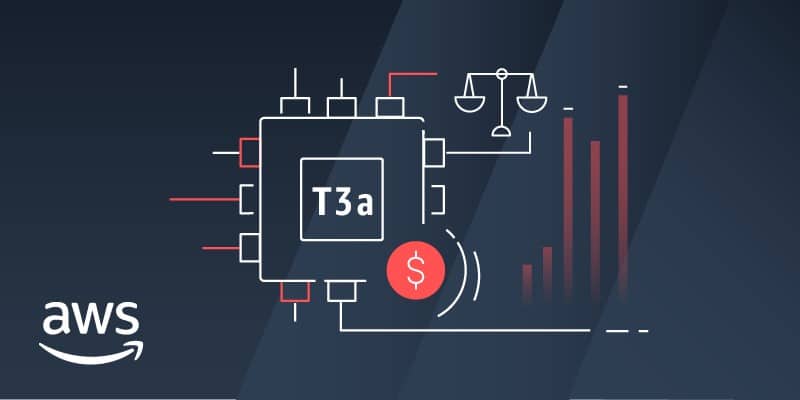
ec2 T3a instance type
They come as the newest generation of burstable, general-purpose instance types which do the following:
– Give a baseline level for the performance of the CPU
– Bursts the usage of CPU whenever and no matter how long it’s needed
– Provides a balance for memory, network and compute resources
– Created for apps having moderate usage of CPU, which might undergo temporary spikes when used
– Provides a high of 10% for cost savings in comparison with other instance types
– Adds up CPU credits as the workload starts to operate underneath the baseline threshold
Every earned CPU credit gives T3a instance a chance to begin bursting with a performance such as that of a whole CPU core, for a total of one minute upon requirement. T3a instances have the ability to burst at any time for as much time as required in Unlimited mode.
Its Features include:
- “AMD EPYC 7000” series processors (all core turbo clock 2.5 GHz speed)
- Burstable CPU + governed by CPU Credits + stable baseline performance
- Unlimited mode (default) for making sure that the performance is perfect while peak periods occur. Standard mode (option): a calculated cost monthly
- Powered through “Nitro System” (combines dedicated hardware + lightweight hypervisor)
| Instance | vCPU* | CPU Credits/hour | Mem (GiB) | Storage | Network Performance (Gbps) |
| t3a.nano | 2 | 6 | 0.5 | EBS-Only | Up to 5 |
| t3a.micro | 2 | 12 | 1 | EBS-Only | Up to 5 |
| t3a.small | 2 | 24 | 2 | EBS-Only | Up to 5 |
| t3a.medium | 2 | 24 | 4 | EBS-Only | Up to 5 |
| t3a.large | 2 | 36 | 8 | EBS-Only | Up to 5 |
| t3a.xlarge | 4 | 96 | 16 | EBS-Only | Up to 5 |
| t3a.2xlarge | 8 | 192 | 32 | EBS-Only | Up to 5 |
Every single instance has the below specs:
- AMD EPYC 7000 series processors of speed 2.5 GHz
- It is EBS Optimized
- It comes with enhanced Networking
It can be used for the following Cases:
– Micro-services
– Low-latency interactive apps
– Small + medium databases
– Virtual desktops
– Development environments
– Code repositories
– Business-critical apps
4. T2
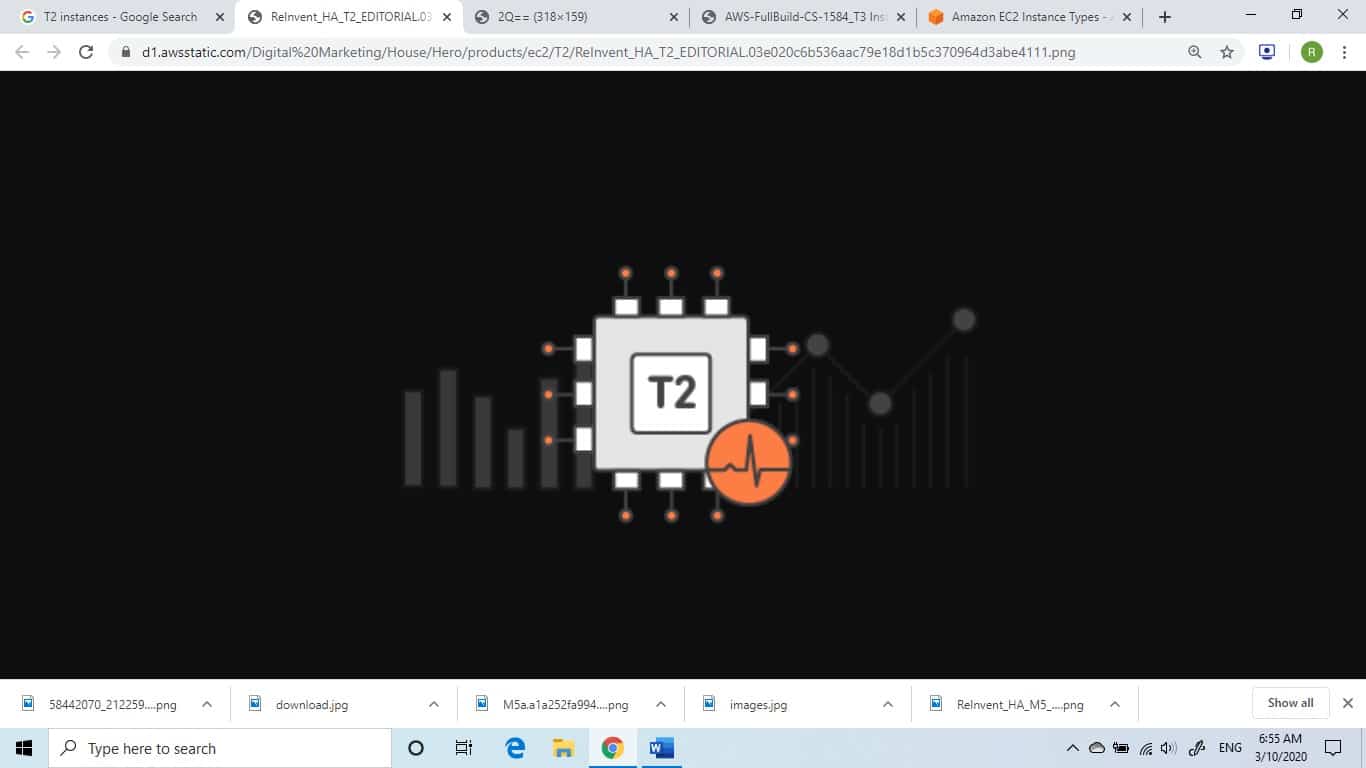
ec2 T2 instance type
Those instances are called “Burstable Performance Instances”, and they offer a baseline level for performance of CPU + capability for bursting over the baseline.
The T2 Unlimited instances can do the following:
– Sustain a high level of CPU performance for as much time as the workload may require
– Offer ample performance with no added costs (general-purpose workloads)
– For 5 cents every vCPU-hour, the instance has the ability to run at a higher level of CPU utilization for an even longer period
CPU credits control baseline performance + the ability to burst. CPU Credits will get received in a continuous manner for a set rate which depends on the following:
– Instance size
– Accumulating CPU Credits when they are idle
– Consuming CPU credits when they are active
T2 instances may be perfect for a wide range of general-purpose workloads such as:
– Micro-services
– Low-latency interactive apps
– Small + medium databases
– Virtual desktops
– Development
– Build and stage environments
– Code repositories
-Product prototypes
Its Features Include:
- Intel Xeon processors with high frequency
- Burstable CPU + governed by CPU Credits + stable baseline performance
- It is the lowest-cost of general-purpose instance type + Free Tier eligible
- Balance of: memory, network and compute resources
Note: t2.micro only.
T2 Unlimited= additional charges when average CPU utilization goes over the baseline of instance
| Instance | vCPU* | CPU Credits/hour | Mem (GiB) | Storage | Network Performance |
| t2.nano | 1 | 3 | 0.5 | EBS-Only | Low |
| t2.micro | 1 | 6 | 1 | EBS-Only | Low to Moderate |
| t2.small | 1 | 12 | 2 | EBS-Only | Low to Moderate |
| t2.medium | 2 | 24 | 4 | EBS-Only | Low to Moderate |
| t2.large | 2 | 36 | 8 | EBS-Only | Low to Moderate |
| t2.xlarge | 4 | 54 | 16 | EBS-Only | Moderate |
| t2.2xlarge | 8 | 81 | 32 | EBS-Only | Moderate |
Every single instance has the below specs:
- Intel AVX + Intel Turbo
- t2.nano + t2.micro + t2.small + t2.medium (up to 3.3 GHz Intel Scalable Processor)
- t2.large + t2.xlarge + t2.2xlarge (up to 3.0 GHz Intel Scalable Processor)
It can be used for the following Cases:
– Websites + web applications
– Development environments
– Build servers
– Code repositories
– Microservices
– Test + staging environments
– Line of business apps
5. M6g
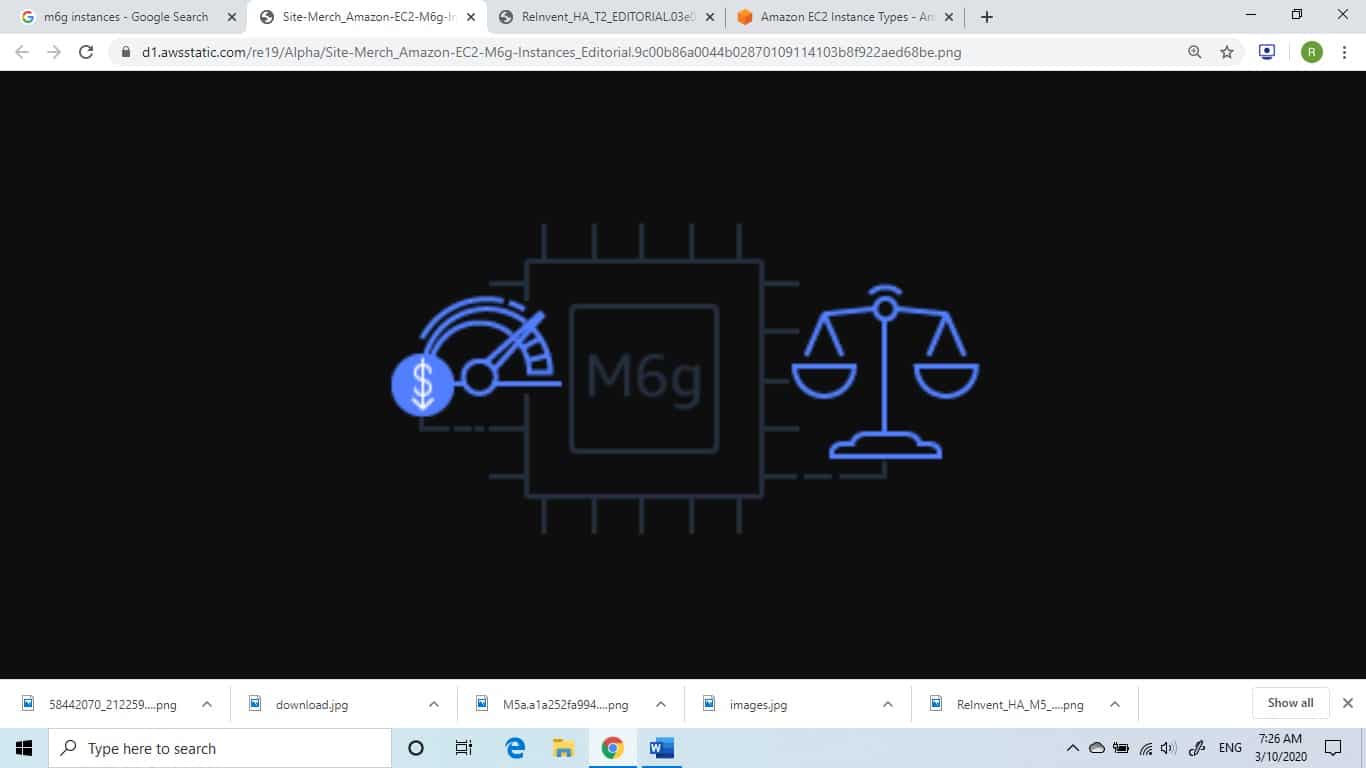
ec2 M6g instance type
Those instances get powered through Arm-based Graviton2 processors. They give up to 40% more enhanced price/performance than the current generation M5 instances. They also provide a balance of memory, networking and compute resources (a broad set of workloads).
| Instance Size | vCPU | Memory (GiB) | Instance Storage | Network Bandwidth (Gbps) | EBS Bandwidth (Mbps) |
| m6g.medium | 1 | 4 | EBS-Only | Up to 10 | Up to 4,750 |
| m6g.large | 2 | 8 | EBS-Only | Up to 10 | Up to 4,750 |
| m6g.xlarge | 4 | 16 | EBS-Only | Up to 10 | Up to 4,750 |
| m6g.2xlarge | 8 | 32 | EBS-Only | Up to 10 | Up to 4,750 |
| m6g.4xlarge | 16 | 64 | EBS-Only | Up to 10 | 4,750 |
| m6g.8xlarge | 32 | 128 | EBS-Only | 12 | 9,000 |
| m6g.12xlarge | 48 | 192 | EBS-Only | 20 | 13,500 |
| m6g.16xlarge | 64 | 256 | EBS-Only | 25 | 18,000 |
Its Features Include:
- Graviton2 Processor, which is custom-built (64-bit Arm Neoverse cores)
- It supports “Enhanced Networking” (Network bandwidth= up to 25 Gbps)
- It is EBS-optimized (default)
- Powered throughNitro System (combines dedicated hardware + lightweight hypervisor)
Every single instance has the below specs:
- “Custom built Graviton2 Processor” (64-bit Arm cores)
- “EBS Optimized”
- “Enhanced Networking”
It is used for the following Cases:
Applications built on open-source software, for example:
– Application servers
– Microservices
– Gaming servers
– Mid-size data stores
– Caching fleets
6. M5
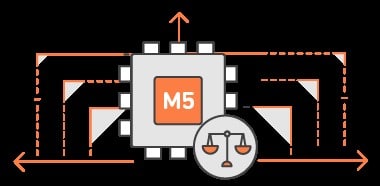
ec2 M5 instance type
The Latest generation for General Purpose Instances that are powered through “Intel Xeon® Platinum 8175M” processors. This family provides a balance of computing, memory, and network resources and is a good choice for many applications.
Its Features Include:
- 1 GHz Intel Xeon® Platinum 8175M processors
- Intel Advanced Vector Extension (AVX-512) instruction set
- Greater instance size (m5.24xlarge) which gives 96 vCPUs + 384 GiB memory
- 25 Gbps network bandwidth (Enhanced Networking)
- Needs HVM AMIs which has drivers for ENA + NVMe
- Powered through Nitro System (combination of dedicated hardware + lightweight hypervisor)
- Instance storage through EBS or NVMe SSDs (physically connected to the host server)
- M5d instances: local NVMe-based SSDs (physically attached to host server + give block-level storage which gets coupled to a lifetime of M5 instance
- 8xlarge and 16xlarge sizes that are newly available.
| Instance Size | vCPU | Memory (GiB) | Instance Storage (GiB) |
Network Bandwidth (Gbps) | EBS Bandwidth (Mbps) |
| m5.large | 2 | 8 | EBS-Only | Up to 10 | Up to 4,750 |
| m5.xlarge | 4 | 16 | EBS-Only | Up to 10 | Up to 4,750 |
| m5.2xlarge | 8 | 32 | EBS-Only | Up to 10 | Up to 4,750 |
| m5.4xlarge | 16 | 64 | EBS-Only | Up to 10 | 4,750 |
| m5.8xlarge | 32 | 128 | EBS Only | 10 | 6,800 |
| m5.12xlarge | 48 | 192 | EBS-Only | 10 | 9,500 |
| m5.16xlarge | 64 | 256 | EBS Only | 20 | 13,600 |
| m5.24xlarge | 96 | 384 | EBS-Only | 25 | 19,000 |
| m5.metal | 96* | 384 | EBS-Only | 25 | 19,000 |
| m5d.large | 2 | 8 | 1 x 75 NVMe SSD | Up to 10 | Up to 4,750 |
| m5d.xlarge | 4 | 16 | 1 x 150 NVMe SSD | Up to 10 | Up to 4,750 |
| m5d.2xlarge | 8 | 32 | 1 x 300 NVMe SSD | Up to 10 | Up to 4,750 |
| m5d.4xlarge | 16 | 64 | 2 x 300 NVMe SSD | Up to 10 | 4,750 |
| m5d.8xlarge | 32 | 128 | 2 x 600 NVMe SSD | 10 | 6,800 |
| m5d.12xlarge | 48 | 192 | 2 x 900 NVMe SSD | 10 | 9,500 |
| m5d.16xlarge | 64 | 256 | 4 x 600 NVMe SSD | 20 | 13,600 |
| m5d.24xlarge | 96 | 384 | 4 x 900 NVMe SSD | 25 | 19,000 |
| m5d.metal | 96* | 384 | 4 x 900 NVMe SSD | 25 | 19,000 |
Note: m5.metal + m5d.metal offer 96 logical processors on 48 physical cores (running on single servers having 2 physical Intel sockets)
Every single instance has the below specs:
- Has 3.1 GHz Intel Xeon Platinum Processor
- Intel AVX + Intel AVX2 + Intel Turbo
- Is EBS Optimized
- Has Enhanced Networking
It can be used in the following Cases:
– Small + mid-size databases
– Tasks for processing data that need more memory
– Caching fleets
– Running backend servers for: SAP + Microsoft SharePoint + cluster computing + other enterprise apps
7. M5a
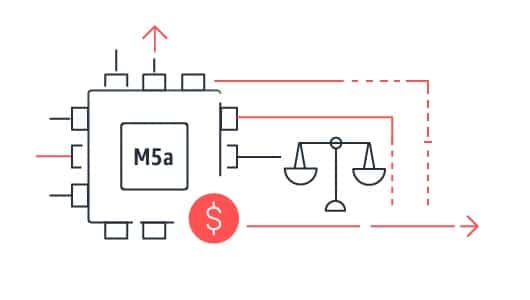
ec2 M5a instance type
They are known for being the latest generation of General Purpose Instances that are powered through AMD EPYC 7000 series processors. They offer up to 10% savings on cost in comparison with different instance types.
Its Features Include:
- Has AMD EPYC 7000 series processors
- All-core turbo clock speed of 2.5 GHz
- 20 Gbps network bandwidth (Enhanced Networking)
- Needs HVM AMIs which have drivers for ENA + NVMe
- It is powered through Nitro System (combines dedicated hardware + lightweight hypervisor)
- Instance storage is provided by EBS or NVMe SSDs (physically connected to the host server)
- M5ad instances= local NVMe-based SSDs become physically attached to the host server to offer block-level storage (coupled to the lifetime of the M5a instance)
| Instance Size | vCPU | Memory (GiB) | Instance Storage (GiB) |
Network Bandwidth (Gbps) | EBS Bandwidth (Mbps) |
| m5a.large | 2 | 8 | EBS-Only | Up to 10 | Up to 2,880 |
| m5a.xlarge | 4 | 16 | EBS-Only | Up to 10 | Up to 2,880 |
| m5a.2xlarge | 8 | 32 | EBS-Only | Up to 10 | Up to 2,880 |
| m5a.4xlarge | 16 | 64 | EBS-Only | Up to 10 | 2,880 |
| m5a.8xlarge | 32 | 128 | EBS Only | Up to 10 | 4,750 |
| m5a.12xlarge | 48 | 192 | EBS-Only | 10 | 6,780 |
| m5a.16xlarge | 64 | 256 | EBS Only | 12 | 9,500 |
| m5a.24xlarge | 96 | 384 | EBS-Only | 20 | 13,750 |
| m5ad.large | 2 | 8 | 1 x 75 NVMe SSD | Up to 10 | Up to 2,880 |
| m5ad.xlarge | 4 | 16 | 1 x 150 NVMe SSD | Up to 10 | Up to 2,880 |
| m5ad.2xlarge | 8 | 32 | 1 x 300 NVMe SSD | Up to 10 | Up to 2,880 |
| m5ad.4xlarge | 16 | 64 | 2 x 300 NVMe SSD | Up to 10 | 2,880 |
| m5ad.12xlarge | 48 | 192 | 2 x 900 NVMe SSD | 10 | 6,870 |
| m5ad.24xlarge | 96 | 384 | 4 x 900 NVMe SSD | 20 | 13,750 |
Every single instance has the below specs:
- AMD EPYC 7000 series processors (2.5 GHz)
- It is EBS Optimized
- It has Enhanced Networking
Used in the following Cases:
– Small + mid-size databases
– Data processing tasks needing extra memory
– Caching fleets
– Running backend servers for the following: SAP + Microsoft SharePoint + cluster computing + other enterprise apps
8. M5n
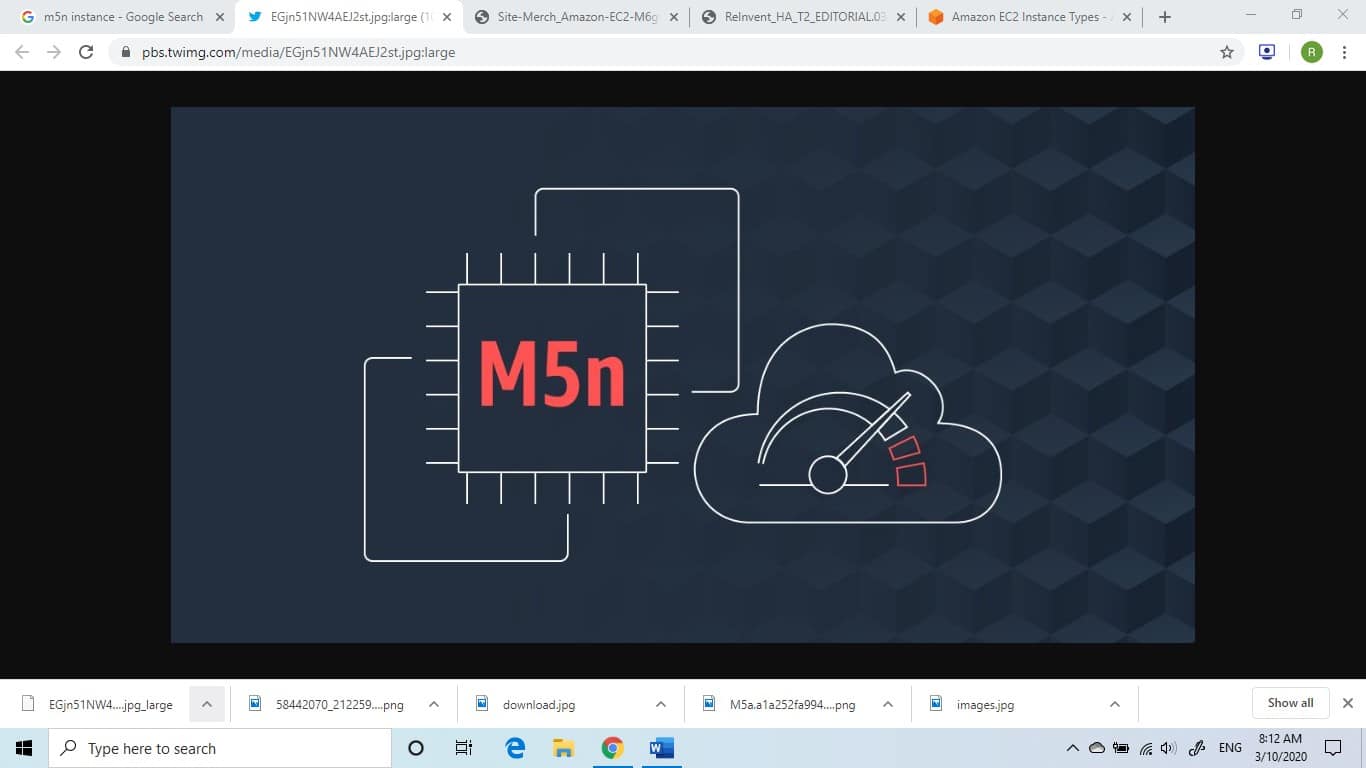
ec2 M5n instance type
Ideal for workloads that need a balance of memory, networking and compute resources, such as:
– Web + application servers
– Small + mid-sized databases
– Cluster computing
– Gaming servers
– Caching fleet
The higher bandwidth instance variants (M5n + M5dn) are perfect for apps that make use of enhanced network throughput + packet rate performance.
Its Features Include:
- 2nd generation Intel Xeon Scalable Processors (Cascade Lake)
- Sustained all-core Turbo CPU frequency (3.1 GHz)
- Maximum single-core turbo frequency (3.5 GHz)
- Supports Intel Vector Neural Network Instructions (AVX-512 VNNI) (increase the speed of basic machine learning operations such as convolution + directly enhance inference performance for a variety of deep learning workloads
- Has 25 Gbps: peak bandwidth (smaller instance sizes)
- Has 100 Gbps: network bandwidth (largest instance size)
- Needs HVM AMIs which have drivers for ENA + NVMe
- Powered through Nitro System (combines dedicated lightweight hardware hypervisor)
- Provides instance storage by EBS or NVMe SSDs (physically connected to host server)
- M5dn instances: local NVMe-based SSDs (physically attached to host server + offer block-level storage – coupled to a lifetime of M5 instance)
| Instance Size | vCPU | Memory (GiB) | Instance Storage (GiB) |
Network Bandwidth (Gbps) | EBS Bandwidth (Mbps) |
| m5n.large | 2 | 8 | EBS-Only | Up to 25 | Up to 4,750 |
| m5n.xlarge | 4 | 16 | EBS-Only | Up to 25 | Up to 4,750 |
| m5n.2xlarge | 8 | 32 | EBS-Only | Up to 25 | Up to 4,750 |
| m5n.4xlarge | 16 | 64 | EBS-Only | Up to 25 | 4,750 |
| m5n.8xlarge | 32 | 128 | EBS Only | 25 | 6,800 |
| m5n.12xlarge | 48 | 192 | EBS-Only | 50 | 9,500 |
| m5n.16xlarge | 64 | 256 | EBS Only | 75 | 13,600 |
| m5n.24xlarge | 96 | 384 | EBS-Only | 100 | 19,000 |
| m5dn.large | 2 | 8 | 1 x 75 NVMe SSD | Up to 25 | Up to 4,750 |
| m5dn.xlarge | 4 | 16 | 1 x 150 NVMe SSD | Up to 25 | Up to 4,750 |
| m5dn.2xlarge | 8 | 32 | 1 x 300 NVMe SSD | Up to 25 | Up to 4,750 |
| m5dn.4xlarge | 16 | 64 | 2 x 300 NVMe SSD | Up to 25 | 4,750 |
| m5dn.8xlarge | 32 | 128 | 2 x 600 NVMe SSD | 25 | 6,800 |
| m5dn.12xlarge | 48 | 192 | 2 x 900 NVMe SSD | 50 | 9,500 |
| m5dn.16xlarge | 64 | 256 | 4 x 600 NVMe SSD | 75 | 13,600 |
| m5dn.24xlarge | 96 | 384 | 4 x 900 NVMe SSD | 100 | 19,000 |
Every instance has the below specs:
- Custom 2nd generation Intel Xeon Scalable Processors (Cascade Lake)
- Sustained all-core Turbo CPU frequency (3.1 GHz)
- Maximum single-core turbo frequency (3.5 GHz)
- Intel AVX + Intel AVX2 + Intel AVX-512 + Intel Turbo + Intel DL Boost
- It is EBS Optimized
- It has Enhanced Networking
Used in the Cases of:
– Web + application servers
– Small + mid-sized databases
– Cluster computing
– Gaming servers
– Caching fleets
– Other enterprise apps
9. M4
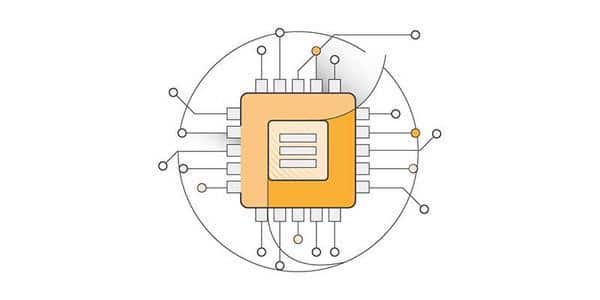
ec2 M4 instance type
M4 instances offer a balance of memory, network and compute resources. They are a great option to go with for multiple apps.
Its Features Include the below listed:
- 3 GHz: Intel Xeon® E5-2686 v4 (Broadwell) processors
- 4 GHz: Intel Xeon® E5-2676 v3 (Haswell) processors
- It is EBS-optimized (default + no extra cost)
- It supports Enhanced Networking
- Balance of: memory, network and compute resources
| Instance | vCPU* | Mem (GiB) | Storage | Dedicated EBS Bandwidth (Mbps) | Network Performance |
| m4.large | 2 | 8 | EBS-only | 450 | Moderate |
| m4.xlarge | 4 | 16 | EBS-only | 750 | High |
| m4.2xlarge | 8 | 32 | EBS-only | 1,000 | High |
| m4.4xlarge | 16 | 64 | EBS-only | 2,000 | High |
| m4.10xlarge | 40 | 160 | EBS-only | 4,000 | 10 Gigabit |
| m4.16xlarge | 64 | 256 | EBS-only | 10,000 | 25 Gigabit |
Every single instance has the below specs:
- Intel Xeon E5-2676 v3 Processor (2.4 GHz)
- Intel AVX + Intel AVX2 + Intel Turbo
- It is EBS Optimized
- It has Enhanced Networking
Used for the following Cases:
– Small + mid-size databases
– Tasks for data processing that are in need of extra memory
– Caching fleets
– Running backend servers for: SAP + Microsoft SharePoint + cluster computing + other enterprise apps
Hint: M4 instances can be launched on an Intel Xeon E5-2686 v4 (Broadwell) processor.
Overall Notes:
Every vCPU comes as a thread of one of the following: Intel Xeon core or AMD EPYC core. (except for: M6g instances & A1 instances & T2 instances & m3.medium).
Every vCPU on M6g instances: the core of Graviton2 processor.
Every vCPU on A1 instances: the core of Graviton Processor.
AVX + AVX2 + Enhanced Networking: available on instances (with HVM AMIs).
See Also